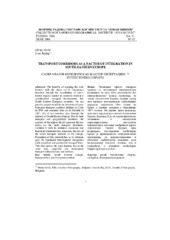Приказ основних података о документу
Transport corridors as a factor of integration in South-Eastern Europe
Saobraćajni koridori kao faktor integracije u jugoistočnoj Evropi
| dc.creator | Grčić, Mirko | |
| dc.creator | Ratkaj, Ivan | |
| dc.date.accessioned | 2021-09-24T15:11:25Z | |
| dc.date.available | 2021-09-24T15:11:25Z | |
| dc.date.issued | 2004 | |
| dc.identifier.issn | 0350-7599 | |
| dc.identifier.uri | https://gery.gef.bg.ac.rs/handle/123456789/96 | |
| dc.description.abstract | The benefits of opening the state borders with the stress on its integration function through the constitution of cross-border regions cannot be achieved without a synchronized transport development. For South Eastern European countries, the top priority project would be the formation of pan-European transport corridors defined on Crete in 1994 and amended later on in Helsinki in 1997. Six of ten corridors pass through the territory of South Eastern Europe. Due to their transport and geographical locations, the capitals of the region should represent the key nodes on the main transport directions. Corridor X with its technical, economic and functional characteristics represents the axis of the entire transport network in SE Europe. Formation of this network has as its ultimate goal the functional inter-regional integration with simplified and accelerated transport lines. This also means the open barriers but at the same time, improved and harmonized transport infrastructures and services. | en |
| dc.description.abstract | Pozitivni efekti otvaranja granica sa naglašenom integracionom funkcijom ne mogu biti realizovani bez sinhronizovanog razvoja saobraćaja. Za zemlje Jugoistočne Evrope, najveći značaj ima projekat pan-evropskih saobraćajnih koridora, definisan 1994. godine na Kritu a kasnije dopunjen u Helsinkiju 1997. godine. Od ukupno deset koridora, njih šest prolazi kroz region Jugoistočne Evrope. Koridor X je, po svojim fizičkim, tehničkim i ekonomskim karakteristikama, postojećim kapacitetima, okosnica saobraćajne mreže Jugoistočne Evrope. Krajnji cilj formiranja pan-evropske saobraćajne mreže je funkcionalna međuregionalna integracija, sa pojednostavljenim i ubrzanim saobraćajnim tokovima, koji podrazumevaju otvorene granice, ali i unapređene i usklađene saobraćajne infrastrukture i usluge. | sr |
| dc.publisher | Beograd : Srpska akademija nauka i umetnosti SANU - Geografski institut "Jovan Cvijić" | |
| dc.rights | openAccess | |
| dc.rights.uri | https://creativecommons.org/licenses/by-nc-nd/4.0/ | |
| dc.source | Zbornik radova Geografskog instituta "Jovan Cvijić", SANU | |
| dc.subject | South Eastern Europe | en |
| dc.subject | transportation | en |
| dc.subject | pan-European corridors | en |
| dc.subject | Jugoistočna Evropa | sr |
| dc.subject | saobraćaj | sr |
| dc.subject | panevropski koridori | sr |
| dc.title | Transport corridors as a factor of integration in South-Eastern Europe | en |
| dc.title | Saobraćajni koridori kao faktor integracije u jugoistočnoj Evropi | sr |
| dc.type | article | |
| dc.rights.license | BY-NC-ND | |
| dcterms.abstract | Раткај, Иван; Грчић, Мирко; Саобраћајни коридори као фактор интеграције у југоисточној Европи; Саобраћајни коридори као фактор интеграције у југоисточној Европи; | |
| dc.citation.issue | 53 | |
| dc.citation.spage | 7 | |
| dc.citation.epage | 25 | |
| dc.citation.other | (53): 7-25 | |
| dc.identifier.fulltext | https://gery.gef.bg.ac.rs/bitstream/id/848/94.pdf | |
| dc.identifier.rcub | https://hdl.handle.net/21.15107/rcub_gery_96 | |
| dc.type.version | publishedVersion |


